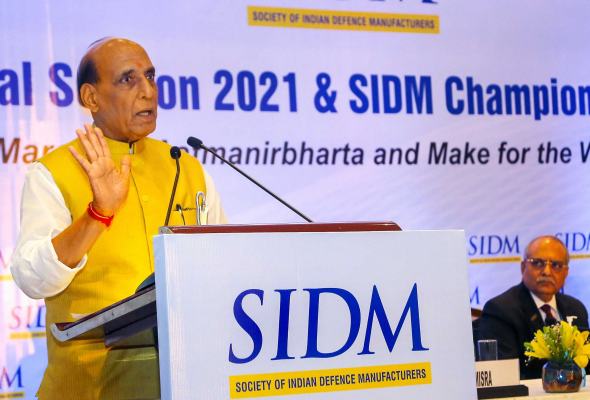
Union Defence Minister during Society of Indian Defence Manufacturers (SIDM) Annual General Meeting in New Delhi, Tuesday, Sept. 28, 2021. A PTI Photo
NEW DELHI (PTI): Indian Defence Minister Rajnath Singh has urged private sector defence companies to invest in research and development to boost production, stressing that rapid changes in the global security scenarios are expected to increase demand for military equipment.
Secretary, Defence Production, Raj Kumar said the armed forces are looking at procuring military equipment and platforms worth Rs 15 to 16 lakh crore in the next few years that include items worth Rs 7.9 lakh crore that are in the planning stage of the procurement and yet to be finalised.
In an address on Tuesday at the annual session of the Society of Indian Defence Manufacturers, the defence minister said countries around the world are now focusing on the modernisation of their militaries and the demand for military equipment is increasing due to emerging security concerns, border disputes and maritime dominance.
"India is capable of meeting these needs through a cost-effective and quality approach. By India, we mean public sector, private sector, academia, research and development. We believe in taking them all on board together," said Singh.
He said the Indian defence industry is home to manufacturers who can create a perfect blend of state-of-the-art, high quality and cost-effective hardware which will not only bolster national security but make the country a net defence exporter.
He reiterated the government's resolve of 'Make in India' and 'Make for the world' through past learnings, present works, with a focus on empowering the future.
Singh said the Indian defence industry should take advantage of the policy reforms initiated by the government in the last few years to boost domestic defence manufacturing.
"You are all aware that the global situation is changing very rapidly. There is no region in the world today that has not been affected by these changes," he said.
"Its impact can be seen on trade, economy, communication, political equation and military power," Singh said, adding these changes are set to spur demand for military equipment.
In this context, he urged the private sector to invest in research and development with a special focus on cyberspace.
"We are providing a suitable growth environment to the private sector. Accordingly, we have opened up opportunities to build fighter jets, helicopters, submarines and tanks in India through the strategic partnership model," Singh said.
Underlining the importance of indigenisation, Singh listed out a number of reforms undertaken by the government to encourage the participation of the private sector.
These included earmarking 64.09 percent of the total capital acquisition budget for 2021-22 for domestic capital procurement and 15 percent of capital procurement budget for direct procurement from private industry, he said.
In his address, Kumar said the existing contracted value for procurement of various equipment from domestic sources is Rs 190,000 crore and that from foreign companies is Rs 185,000 crore.
Separately, he said the Defence Acquisition Council accorded Acceptance of Necessity (AoN) for procurement of military hardware worth Rs 375,000 crore from domestic industry and equipment valued at Rs 111,000 crore from foreign sources.
He said the services are also planning to acquire equipment worth Rs 577,000 crore from domestic industry and the platforms worth Rs 211,000 crore from foreign countries.
The total comes to around a staggering Rs 15-16 lakh crore, he said.
Another official said the defence ministry has given a four-month extension of the delivery period to various suppliers during the first COVID-19 wave and another two-and-half-month extension in the second wave.
The government has initiated a series of measures in the last couple of years to encourage the domestic defence industry.
In August last year, Singh announced that India will stop the import of 101 weapons and military platforms like transport aircraft, light combat helicopters, conventional submarines, cruise missiles and sonar systems by 2024.
A second negative list, putting import restrictions on 108 military weapons and systems such as next-generation corvettes, airborne early warning systems, tank engines and radars, was issued recently.
In May last year, the government announced increasing the FDI limit from 49 percent to 74 percent under the automatic route in the defence sector.
The government has been focusing on reducing dependence on imported military platforms and has decided to support domestic defence manufacturing.
The defence ministry has set a goal of a turnover of USD 25 billion (Rs 1.75 lakh crore) in defence manufacturing by 2025 that included an export target of USD 5 billion (Rs 35,000 crore) worth of military hardware.
 Previous Article
Previous Article Next Article
Next Article













The Indian Air Force, in its flight trials evaluation report submitted before the Defence Ministry l..
view articleAn insight into the Medium Multi-Role Combat Aircraft competition...
view articleSky enthusiasts can now spot the International Space Station (ISS) commanded by Indian-American astr..
view article